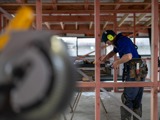What does earthquake prone buildings (EPB) mean?
A building is earthquake prone if a building or a part of building can collapse on a person or onto other properties and cause injury or death to a person or damage to other buildings.
Council identifies earthquake prone buildings by using the Earthquake Prone Building methodology which outlines how territorial authorities should identify earthquake prone buildings, how engineers undertake assessments, and sets out the timeframes for remedial action.
An earthquake prone assessment is undertaken by an engineer that assigns an earthquake rating to a building.
This earthquake rating means a buildings seismic resistance capacity in the event of an earthquake and is calculated in comparison to a new build standard (NBS). A building with a rating of less than 34% NBS is deemed to be earthquake prone and those with a rating of more than 67% NBS are deemed to be unlikely to be a risk in the event of an earthquake.
View the New Zealand Seismic Risk area map for more information.
What does percentile NBS or NBS rating mean?
The Initial NBS, or New Building Standard rating, is a high-level assessment of the seismic risk of a building, compared to a building built to the current building code. This assessment does not predict if a building would survive in an earthquake but is rather a representation of the vulnerability of a building in the event of an earthquake.
Key information
Dive a bit deeper into the topic with our key information below to make your building earthquake safe.




